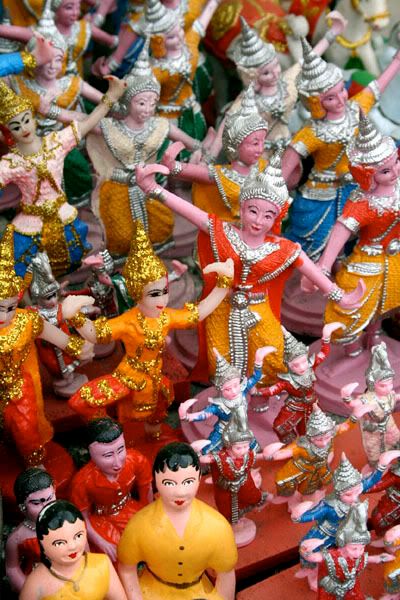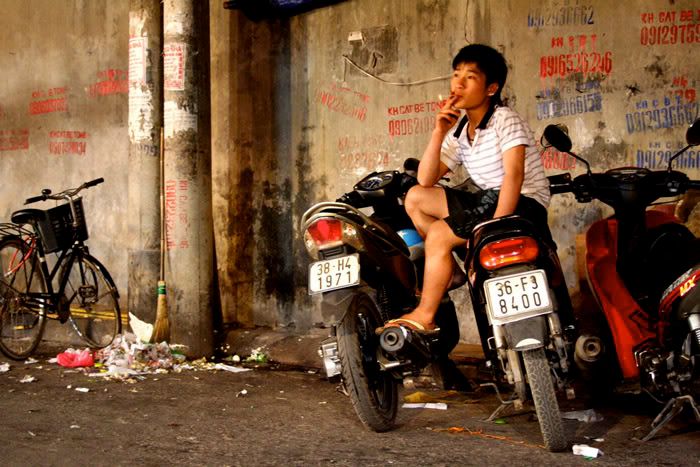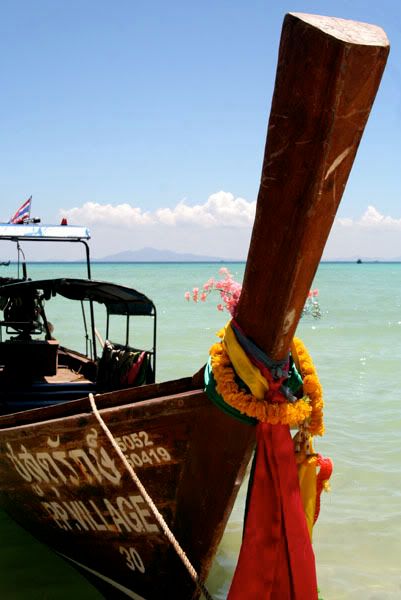 I'm generally not an island person, and I've never been big on beaches. But sharing a crisp banana roti on white sand in Ko Phi Phi may just have been enough to convert me- should I make this postcard a change of address card?
I'm generally not an island person, and I've never been big on beaches. But sharing a crisp banana roti on white sand in Ko Phi Phi may just have been enough to convert me- should I make this postcard a change of address card?
Monday, March 31, 2008
Postcard from Ko Phi Phi.
 I'm generally not an island person, and I've never been big on beaches. But sharing a crisp banana roti on white sand in Ko Phi Phi may just have been enough to convert me- should I make this postcard a change of address card?
I'm generally not an island person, and I've never been big on beaches. But sharing a crisp banana roti on white sand in Ko Phi Phi may just have been enough to convert me- should I make this postcard a change of address card?
Themes:
Southeast Asia,
Thai Islands and Beaches,
Thailand
Friday, March 28, 2008
Lunch over a lotus pond.
 For my sister's visit, Bordeaux and I made our first trip to Southern Thailand. We arrived at the Krabi airport in the early afternoon, and after lunch at a Muslim canteen in town, caught a taxi out to our resort. Along the road, we traveled among craggy vine-entangled karsts and overgrown forest. I was enthralled by the passing greenery. I had come to Krabi expecting sparkling beaches and blue tide; I hadn't come expecting jungle.
For my sister's visit, Bordeaux and I made our first trip to Southern Thailand. We arrived at the Krabi airport in the early afternoon, and after lunch at a Muslim canteen in town, caught a taxi out to our resort. Along the road, we traveled among craggy vine-entangled karsts and overgrown forest. I was enthralled by the passing greenery. I had come to Krabi expecting sparkling beaches and blue tide; I hadn't come expecting jungle.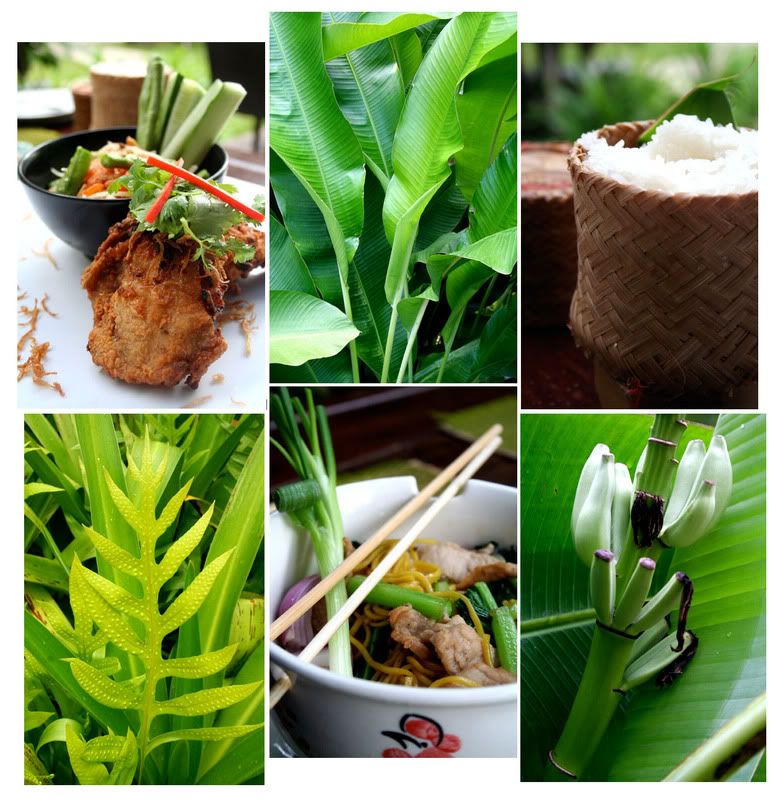 Once unpacked, we gave in completely to relaxation. I'm usually an overly active traveler, but after two intense weeks in Vietnam, it felt great to just chill out. We spent most of our days by the beach or in the pool, and when meals rolled around we didn't feel like walking very far. Thankfully, there was a decent selection of places, even on our small beach. After reviewing menus, we found a particularly good restaurant at the Tubkaek Resort. Aside from the extensive list of tropical cocktails, we were drawn by the skillful kitchen, who served an interesting Thai menu that included a number of local Southern specialties. For one lunch, we ate tasty Hokkien noodles, and a spicy Krabi-style chicken with sticky rice and papaya salad. But as delicious as the food was, it was outshone by the lush tropical environment. Meals were served on a wood platform over a lotus pond, and the surrounded garden was landscaped with fiery red ginger, yellow-green banana trees, and dripping turquoise palms.
Once unpacked, we gave in completely to relaxation. I'm usually an overly active traveler, but after two intense weeks in Vietnam, it felt great to just chill out. We spent most of our days by the beach or in the pool, and when meals rolled around we didn't feel like walking very far. Thankfully, there was a decent selection of places, even on our small beach. After reviewing menus, we found a particularly good restaurant at the Tubkaek Resort. Aside from the extensive list of tropical cocktails, we were drawn by the skillful kitchen, who served an interesting Thai menu that included a number of local Southern specialties. For one lunch, we ate tasty Hokkien noodles, and a spicy Krabi-style chicken with sticky rice and papaya salad. But as delicious as the food was, it was outshone by the lush tropical environment. Meals were served on a wood platform over a lotus pond, and the surrounded garden was landscaped with fiery red ginger, yellow-green banana trees, and dripping turquoise palms.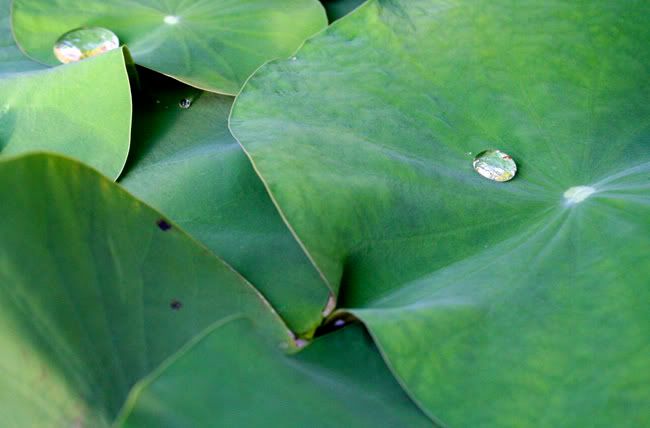
Wednesday, March 26, 2008
An ancient capital revisited.
 What a difference a crowd makes. I had spent a day visiting ruins in Ayutthaya back in June; I struggled to weave between crowds of school girls for most of it. On this return trip, we found the ruins almost deserted, in the searing solitude of a hot-season day. While the sun browned our skin to the same color as the gold-leafed icons, we were able to admire the grandeur of the old temples in near seclusion.
What a difference a crowd makes. I had spent a day visiting ruins in Ayutthaya back in June; I struggled to weave between crowds of school girls for most of it. On this return trip, we found the ruins almost deserted, in the searing solitude of a hot-season day. While the sun browned our skin to the same color as the gold-leafed icons, we were able to admire the grandeur of the old temples in near seclusion.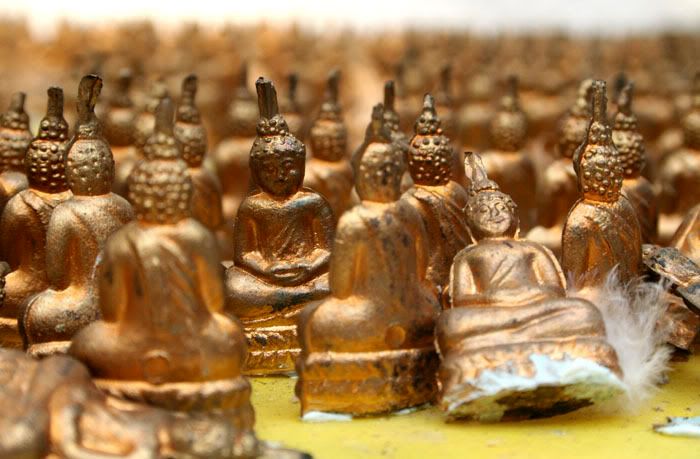
Monday, March 24, 2008
Friday, March 21, 2008
Welcomed back by the spices of Bangkok.
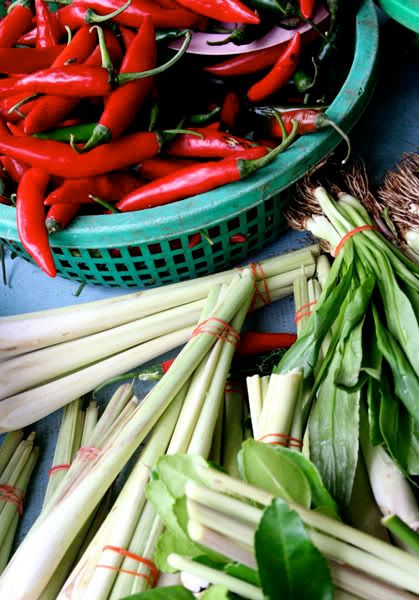 While walking past my local morning market on my first day back in Bangkok, I was woken by the scent of chili, star anise, lemongrass, and sweet Thai coffee. Perhaps it was simply because I had been gone for so long, but the air seemed to be more filled with delicious fragrances and spices than ever. In a single breath it reminded me of how exciting and exotic the city I live in is. If it was partly the delicious Vietnamese food that lured me into loving Hanoi, it was perfectly fitting that it was the food of Thailand that welcomed me home to Bangkok.
While walking past my local morning market on my first day back in Bangkok, I was woken by the scent of chili, star anise, lemongrass, and sweet Thai coffee. Perhaps it was simply because I had been gone for so long, but the air seemed to be more filled with delicious fragrances and spices than ever. In a single breath it reminded me of how exciting and exotic the city I live in is. If it was partly the delicious Vietnamese food that lured me into loving Hanoi, it was perfectly fitting that it was the food of Thailand that welcomed me home to Bangkok.
Themes:
Bangkok,
food,
Southeast Asia,
Thai Food and Coffee,
Thailand
Thursday, March 20, 2008
culturedPRIMITIVE/style: Souvenirs of Indochine.
 And so, with more than a little regret, we left Vietnam. We really had an awesome time in Hanoi- it's such an amazing city, with incredible food, intriguing architecture, and an engagingly artistic atmosphere. To console ourselves, we took a few things with us from Vietnam. Here are a few of the more interesting items that we brought back with us.
And so, with more than a little regret, we left Vietnam. We really had an awesome time in Hanoi- it's such an amazing city, with incredible food, intriguing architecture, and an engagingly artistic atmosphere. To console ourselves, we took a few things with us from Vietnam. Here are a few of the more interesting items that we brought back with us.1. Highland Coffee and a Vietnamese Drip. The memory of Vietnam I most wanted to retain was of the delicious coffee. So the first essential souvenir we tracked down were the small metal Vietnamese drips. Later, we sought out the best coffee beans. After sampling several blends at an outlet in the Old Quarter, we chose the Highlands coffee (not connected to the same-named coffee chain). It had a particularly rich flavor, with strong hints of chocolate.
2. Hmong Boy bookmark. The beautifully sewn clothing worn by the Hmong appear in countless postcards and paintings in Northern Vietnam. For some reason, however, these images tend to focus only on the women. Despite being largely ignored, Hmong men actually wear a very intriguing outfit- boots, black shorts, a long jacket, and cap. So when we finally found a paper bookmark featuring one of the Hmong men, we had to get it.
3. Cooking chopsticks. At the end of our cooking course at Hidden Hanoi, Bordeaux and I were each given a set of these extra-long wooden chopsticks, which are perfect for turning spring-rolls in a frying pan.
4. Green pea cakes. It's hard to say what's so addictive about these little green pea cakes. Certainly it's not the chalky texture, or the vague flavor of dry peanut butter. Perhaps its simply the wonderfully unhip graphics on the box.
5. Cinnamon wood box. Our second hotel in Hanoi was located right next door to Marena Hanoi, a wonderful little homewares store that specialized in chic ceramics and elegant lacquerware. There, we found this square box of cinnamon wood, which gives off a deliciously spicy scent. It is currently at use in our kitchen, imbuing the coffee stored within with a cinnamon aroma.
6. Rubber stamps. On our last night in Hanoi, Bordeaux and I encountered an alley in the old quarter that specialized in rubber stamps. We couldn't help but pick up a few of the more intriguing ones, which had some iconic Vietnamese images: tigers, lotus ponds, and hooded cobras among them.
7. Hmong blanket. Leaving our hotel in Sapa, we were constantly hounded by Hmong women selling beautiful hand-sewn blankets. Though they came in many colors, from rust to electric green, the ones that most caught my eye were the blankets in deep shades of indigo. I finally found the perfect one, sold by a woman in thick-eyeglasses.
8. Golden Buddha. In the candy markets of the Old Quarter, Bordeaux and I encountered boxes and boxes loaded with sweets, wrapped candies, and boxes of green bean cakes. We also found containers overfilled with tiny gold Buddhas. We purchased one to investigate, and found that it was filled with an unusual gummy treat.
***
Editor's Note: Though this ends my sequential entries on Vietnam, I have much more to write about Hanoi. Look out for essays on Vietnamese coffee and the Colors of Hanoi in the near future.
Cha ca.
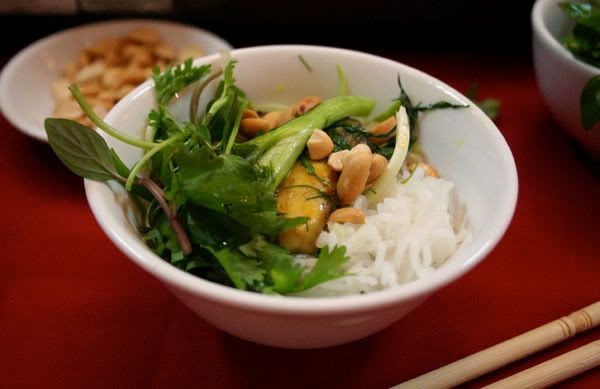 I had planned to take Bordeaux out on our last night in Hanoi, but things didn't go exactly as I planned. The first restaurant I had considered had closed down, and the second was booked for a private event. So with some hesitation, we booked a table at a distant third choice. As the dinner hour approached, I felt more and more uncomfortable with the decision. Considering how great the food in Hanoi is, it seemed wrong to go somewhere that didn't seem perfect for our last night. So at the last moment, we ditched our reservations and sought out a dish we'd been curious about: cha ca.
I had planned to take Bordeaux out on our last night in Hanoi, but things didn't go exactly as I planned. The first restaurant I had considered had closed down, and the second was booked for a private event. So with some hesitation, we booked a table at a distant third choice. As the dinner hour approached, I felt more and more uncomfortable with the decision. Considering how great the food in Hanoi is, it seemed wrong to go somewhere that didn't seem perfect for our last night. So at the last moment, we ditched our reservations and sought out a dish we'd been curious about: cha ca.In Hanoi, cha ca is most famously served at the century-old restaurant Cha Ca La Vong, but after comparing reviews, we decided to instead try Cha Ca Thanh Long. The smart but simple restaurant was packed, but thankfully they found a table for us. 'We only serve one dish,' our waitress explained, as a waiter set out a gas cooker on our table. Igniting the flame, he set to work: he sautéed fish, along with spring onion, tumeric, and large handfuls of fresh dill. He served us each a portion, and left the rest to simmer on our table. The resulting dish, eaten with crunchy peanuts on a pillow of cold noodles, was fresh, sharply flavored, and extremely tasty- a combination that reflected all that we love about Vietnamese food. It was one of those great nights when you're grateful that nothing worked out as planned.
Themes:
food,
Hanoi,
Southeast Asia,
Viet Nam,
Vietnamese Food and Coffee
Tuesday, March 18, 2008
Hanoi Street Food.
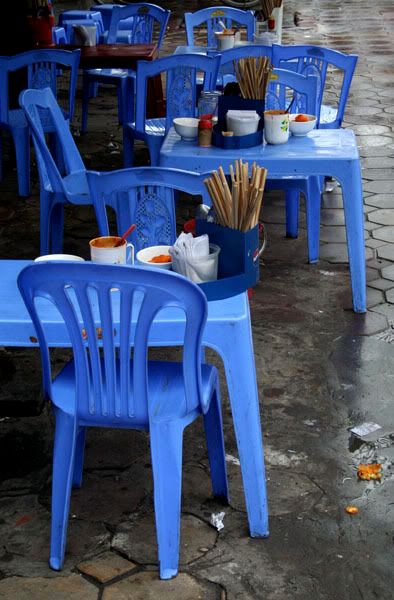 I live in Bangkok, so I'm no stranger to street-side food and sidewalk kitchens. But even so, I was amazed by the variety of delicious food available on the streets of Hanoi. From sour soups of bamboo and duck, to steaming bowls of pho, to baguettes filled with egg and pate, the problem was never finding a good meal, it was choosing what to eat. On our last days in Hanoi, Bordeaux and I weren't only conflicted with how to do everything we wanted, we also struggled to figure out how to eat everything we wanted.
I live in Bangkok, so I'm no stranger to street-side food and sidewalk kitchens. But even so, I was amazed by the variety of delicious food available on the streets of Hanoi. From sour soups of bamboo and duck, to steaming bowls of pho, to baguettes filled with egg and pate, the problem was never finding a good meal, it was choosing what to eat. On our last days in Hanoi, Bordeaux and I weren't only conflicted with how to do everything we wanted, we also struggled to figure out how to eat everything we wanted. In Vietnam, the primary meal people eat on the street is breakfast. In the early hours of the day, the sidewalks are crowded with people lowered onto plastic stools, tucking into bowls of soup and glasses of strong coffee or powerful rice wine. On an early morning out, Bordeaux and I encountered a woman making banh cuon. She spread rice batter out on the taut surface of a steamer drum, smoothed it like a crepe, dropped in some minced pork and shallots, then gathered it all up into loose rolls. She piled these generously onto a plate, then covered the whole pile with fried garlic and shallots. The dish was so much more amazing than its parts- a crunchy, slippery and very flavorful dish to start the day with.
In Vietnam, the primary meal people eat on the street is breakfast. In the early hours of the day, the sidewalks are crowded with people lowered onto plastic stools, tucking into bowls of soup and glasses of strong coffee or powerful rice wine. On an early morning out, Bordeaux and I encountered a woman making banh cuon. She spread rice batter out on the taut surface of a steamer drum, smoothed it like a crepe, dropped in some minced pork and shallots, then gathered it all up into loose rolls. She piled these generously onto a plate, then covered the whole pile with fried garlic and shallots. The dish was so much more amazing than its parts- a crunchy, slippery and very flavorful dish to start the day with.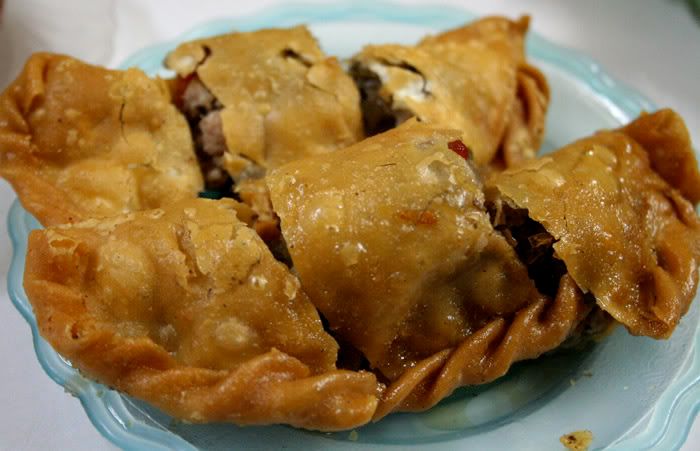 Like in Bangkok, good street food can be found almost everywhere in Hanoi. For example, though the elegant Cathedral district is known primarily for its chic espresso cafes and hip designer boutiques, it also boasts a good range of informal sidewalk kitchens. Just up from the Cathedral square, we visited a little fry-shop that featured a range of simple snacks. Though everything we ate there was good, the tastiest treat was banh ghoi (also: banh goi). It's a small fried pastry with a golden flaky crust that broke open to reveal delicious seasoned pork and mushrooms.
Like in Bangkok, good street food can be found almost everywhere in Hanoi. For example, though the elegant Cathedral district is known primarily for its chic espresso cafes and hip designer boutiques, it also boasts a good range of informal sidewalk kitchens. Just up from the Cathedral square, we visited a little fry-shop that featured a range of simple snacks. Though everything we ate there was good, the tastiest treat was banh ghoi (also: banh goi). It's a small fried pastry with a golden flaky crust that broke open to reveal delicious seasoned pork and mushrooms.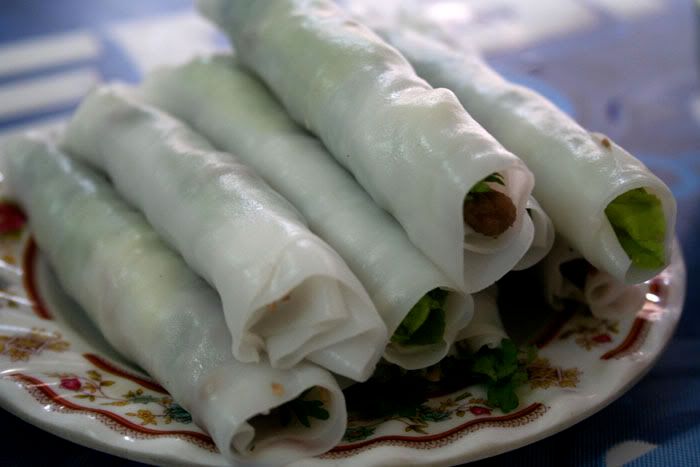 After exploring the neighborhood around West Lake, Bordeaux and I stopped for a snack on the little island of Ngu Xa. The local specialty is pho cuon, and though we weren't sure if we'd be able to find any, we quickly discovered that nearly every shop in the area was advertising them. It thus became not a matter of finding them, but a question of deciding which one to try. We searched out the shop that appeared the most popular, where a group of high-school age girls were busy packing up boxes of the snack for a line of to-go customers. We took a table, and one of the friendly girls brought us a plate. The smooth white wrapping was tightly packed around delicious strips of beef, which were seasoned with a sprinkling of fresh green herbs.
After exploring the neighborhood around West Lake, Bordeaux and I stopped for a snack on the little island of Ngu Xa. The local specialty is pho cuon, and though we weren't sure if we'd be able to find any, we quickly discovered that nearly every shop in the area was advertising them. It thus became not a matter of finding them, but a question of deciding which one to try. We searched out the shop that appeared the most popular, where a group of high-school age girls were busy packing up boxes of the snack for a line of to-go customers. We took a table, and one of the friendly girls brought us a plate. The smooth white wrapping was tightly packed around delicious strips of beef, which were seasoned with a sprinkling of fresh green herbs.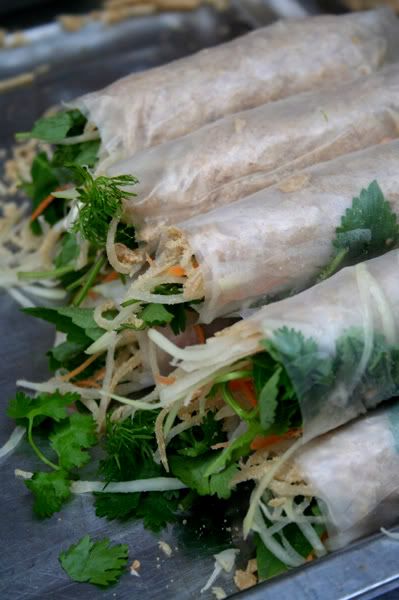 Spring rolls and salad rolls are among the dishes most connected in people's minds with Vietnam, and we did take the chance to sample a few varieities. A tiny stand next to our hotel sold these tasty rolls, made with fresh vegetables, shredded pork skin, and of course, tons of cilantro. The shredded pork skin had an unexpected flavor and texture (salty, with a frayed surface that could almost be described as feeling "furry"), but they added an interesting element to the salad rolls.
Spring rolls and salad rolls are among the dishes most connected in people's minds with Vietnam, and we did take the chance to sample a few varieities. A tiny stand next to our hotel sold these tasty rolls, made with fresh vegetables, shredded pork skin, and of course, tons of cilantro. The shredded pork skin had an unexpected flavor and texture (salty, with a frayed surface that could almost be described as feeling "furry"), but they added an interesting element to the salad rolls. Another popular version of the spring roll is nem cua be, often sold at the same stands that make bun cha. These crunchy rolls of crab meat and glass noodles paired perfectly with the smoky pork and fish sauce soup.
Another popular version of the spring roll is nem cua be, often sold at the same stands that make bun cha. These crunchy rolls of crab meat and glass noodles paired perfectly with the smoky pork and fish sauce soup.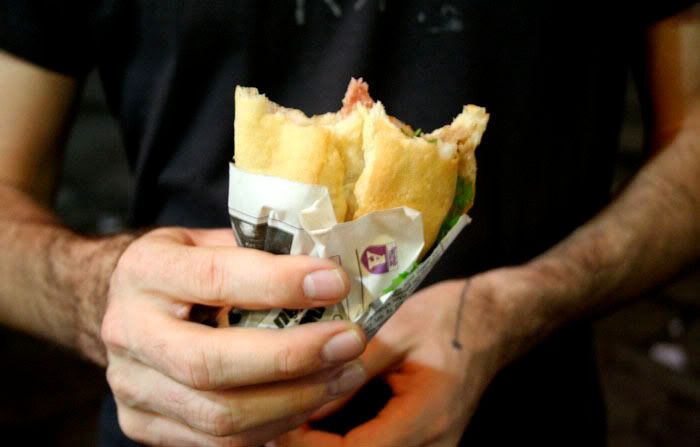 And, ok, I know I've already written about binh my pate twice (here and here), but few dishes can match it. On our last night in Hanoi, Bordeaux and I stopped to pick up one final baguette. Even though we'd had it several times already that week, this one somehow stood out above all the others. It was laced with a deliciously spicy chili sauce that contrasted perfectly with the salty pate and sharp cilantro leaves.
And, ok, I know I've already written about binh my pate twice (here and here), but few dishes can match it. On our last night in Hanoi, Bordeaux and I stopped to pick up one final baguette. Even though we'd had it several times already that week, this one somehow stood out above all the others. It was laced with a deliciously spicy chili sauce that contrasted perfectly with the salty pate and sharp cilantro leaves.*PS- This is my 100th entry written about Southeast Asia! Rather fitting that it's about street-food, I think.
Themes:
breakfast,
food,
Hanoi,
Southeast Asia,
street-food,
Viet Nam,
Vietnamese Food and Coffee
Monday, March 17, 2008
A Cooking Class at Hidden Hanoi.
 Several months ago, when Bordeaux and I were first traveling through Southeast Asia, one of our goals was to take a cooking class in each country we visited. Unfortunately, we only managed to take classes in two- we took a Thai cooking class at The Thai Farm Cooking School in Chiang Mai, and a Lao cooking class at Three Elephants in Luang Phrabang. So in visiting Hanoi, one of our chief desires was to take a class on Vietnamese cooking. After some research online and in travel guides, we decided that the course most suited to our interests was the one offered at Hidden Hanoi.
Several months ago, when Bordeaux and I were first traveling through Southeast Asia, one of our goals was to take a cooking class in each country we visited. Unfortunately, we only managed to take classes in two- we took a Thai cooking class at The Thai Farm Cooking School in Chiang Mai, and a Lao cooking class at Three Elephants in Luang Phrabang. So in visiting Hanoi, one of our chief desires was to take a class on Vietnamese cooking. After some research online and in travel guides, we decided that the course most suited to our interests was the one offered at Hidden Hanoi.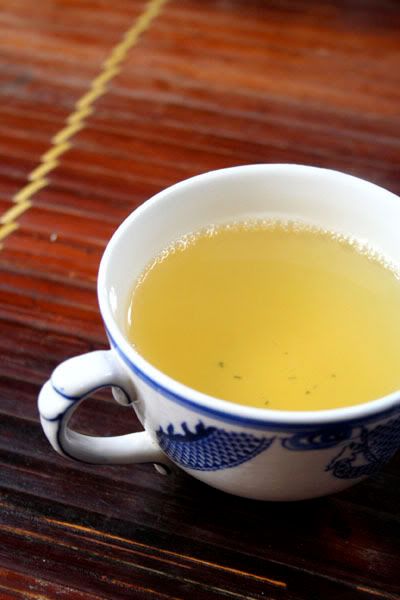 We took a taxi out to Hidden Hanoi, which was located in a beautiful red and gold tube-house near West Lake. From the beginning, there were some minor difference with the other classes we'd taken. The others both started with a tour of a local produce market, but this one began instead with a quiet chat about Vietnamese cuisine. In a sunny room upstairs in the cooking school, our guide An spoke with us over cups of herbal tea. She asked us about what dishes we had tried that we liked, made some comments comparing Thai and Vietnamese flavors, and shared with us some general philosophy about Vietnamese cuisine. An was sweet, engaging and extremely informative, and this opening discussion felt as relaxed as having tea with a friend. I liked that this class followed a different format than most others, and the discussion was a great way to start the course, as it set an inviting atmosphere for the day.
We took a taxi out to Hidden Hanoi, which was located in a beautiful red and gold tube-house near West Lake. From the beginning, there were some minor difference with the other classes we'd taken. The others both started with a tour of a local produce market, but this one began instead with a quiet chat about Vietnamese cuisine. In a sunny room upstairs in the cooking school, our guide An spoke with us over cups of herbal tea. She asked us about what dishes we had tried that we liked, made some comments comparing Thai and Vietnamese flavors, and shared with us some general philosophy about Vietnamese cuisine. An was sweet, engaging and extremely informative, and this opening discussion felt as relaxed as having tea with a friend. I liked that this class followed a different format than most others, and the discussion was a great way to start the course, as it set an inviting atmosphere for the day. We'd selected the Street Food menu, which to us seemed the best introduction to some basic Vietnamese cooking. The principal dish we were to make was bun cha, a dish of marinated barbecue pork that Bordeaux and I had both become addicted to. In addition, we were making fried spring rolls, and we would accompany the dishes with rice noodles, an herb salad, and a light soup of chili and fish sauce. The kitchen set up was rather different than I'd encountered in past classes. At both cooking schools I'd visited previously, we'd each been in charge of a wok (either alone or with a partner), and we'd been responsible for cooking all of the dishes ourselves. In the end, we each had our own oversized meal to ourselves. Here, we worked communally to prepare the dishes that we would all enjoy together. While Bordeaux and another student chopped vegetables for the spring rolls, I sliced pork and mashed lemongrass together with chili to make the bun cha. We each got to try our hand at the different tasks- slicing produce, rolling the spring rolls in the pan, and fanning the barbecuing pork. In part, this seemed necessary since most dishes take a little time to cook- much different than the quick wok frying of the Thai and Lao dishes. But it also contributed to the relaxed, communal vibe of the meal.
We'd selected the Street Food menu, which to us seemed the best introduction to some basic Vietnamese cooking. The principal dish we were to make was bun cha, a dish of marinated barbecue pork that Bordeaux and I had both become addicted to. In addition, we were making fried spring rolls, and we would accompany the dishes with rice noodles, an herb salad, and a light soup of chili and fish sauce. The kitchen set up was rather different than I'd encountered in past classes. At both cooking schools I'd visited previously, we'd each been in charge of a wok (either alone or with a partner), and we'd been responsible for cooking all of the dishes ourselves. In the end, we each had our own oversized meal to ourselves. Here, we worked communally to prepare the dishes that we would all enjoy together. While Bordeaux and another student chopped vegetables for the spring rolls, I sliced pork and mashed lemongrass together with chili to make the bun cha. We each got to try our hand at the different tasks- slicing produce, rolling the spring rolls in the pan, and fanning the barbecuing pork. In part, this seemed necessary since most dishes take a little time to cook- much different than the quick wok frying of the Thai and Lao dishes. But it also contributed to the relaxed, communal vibe of the meal. Additionally, it meant that instead of being overstuffed, we had a perfectly sized meal to share (perhaps even a little too big). We took our beautifully prepared dishes to the table, and had a relaxed afternoon meal. The spring rolls were crispy but fresh, the bun cha beautifully flavored from the marinade, and the noodles and fresh herbs were the perfect foil for the heavyness of the meal. More than just a cooking course, I felt as if we'd been given a brief introduction to Vietnamese culture. Our teacher, An, was a great source of information, and while the meal had been wonderful, and the instruction perfect, more than anything, she made the class worthwhile. It takes a long time to make this meal, An told us, so we don't make it often at home- but when we do, it's always better than you can get on the street. She was definitely right.
Additionally, it meant that instead of being overstuffed, we had a perfectly sized meal to share (perhaps even a little too big). We took our beautifully prepared dishes to the table, and had a relaxed afternoon meal. The spring rolls were crispy but fresh, the bun cha beautifully flavored from the marinade, and the noodles and fresh herbs were the perfect foil for the heavyness of the meal. More than just a cooking course, I felt as if we'd been given a brief introduction to Vietnamese culture. Our teacher, An, was a great source of information, and while the meal had been wonderful, and the instruction perfect, more than anything, she made the class worthwhile. It takes a long time to make this meal, An told us, so we don't make it often at home- but when we do, it's always better than you can get on the street. She was definitely right.*****
Editor's Note: I also just wanted to point out that I am posting my entries sort of out of order as I struggle to catch up. So please either scroll down to see what I've posted, or simply check out my entries on Ha Long Bay, Cat Ba Island, the Ho Chi Minh's Museum, street-food in Sapa, and a particularly delicious dish of binh my pate. Thanks, and hopefully I'll be totally up to date soon! -X
Sunday, March 16, 2008
The balanced bun cha.
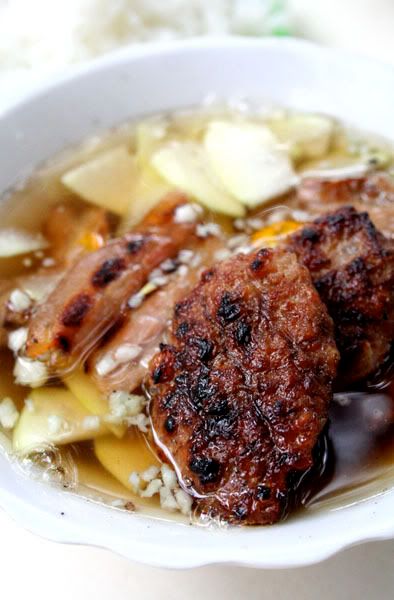
Most cultures have a sense of balance when it comes to eating. In the states, we use the term “balanced meal”, and use the food groups to define a balanced diet, even if we don’t generally employ those characteristics in every meal. In Thailand, we employ the four flavors (sweet, spicy, sour, and salty) to give our dishes a sense of balance. In Vietnam, balance is an essential aspect of a meal, present not only in the dishes themselves, but in the arrangement of dishes. If the main dish is heavy, the accompaniments should be light. If the main dish is light, the accompaniments should be a little heavier. This isn’t true only of elegant meals or lavish dinners, however. This balance can be observed anywhere- even in a simple street-side meal of bun cha.
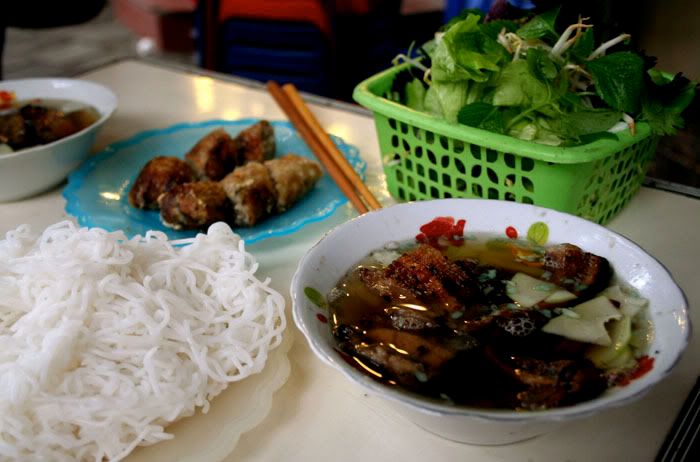 A specialty of Hanoi, bun cha is a deliciously smoky dish of barbecued pork. Walking down the street in Hanoi, it’s hard not to be tempted by the rich woody scent of bun cha sizzling in a sidewalk kitchen. After taking a seat, the waitress confirms our order, and quickly dishes out our food. She first brings the bun cha, ground pork and pork shoulder bacon that have been marinated in chili and lemongrass and grilled over charcoal. It's served in a light soup of fish-sauce, garlic, chili and a sliced crisp vegetable. Since bun cha is fairly heavy, it’s served with two very light dishes. The first is a plate of simple rice noodles, reflective of the role rice plays as foundation for all Vietnamese meals. The second is a basket of raw herbs: purple mint, sawtooth coriander, cilantro, and other mixed greens. By alternating tastes of the richly flavored meat with cleansing mouthfuls of noodles or sharp fresh bites of herbs, the heaviness of the meal is lifted, creating a filling lunch that doesn’t weigh us down.
A specialty of Hanoi, bun cha is a deliciously smoky dish of barbecued pork. Walking down the street in Hanoi, it’s hard not to be tempted by the rich woody scent of bun cha sizzling in a sidewalk kitchen. After taking a seat, the waitress confirms our order, and quickly dishes out our food. She first brings the bun cha, ground pork and pork shoulder bacon that have been marinated in chili and lemongrass and grilled over charcoal. It's served in a light soup of fish-sauce, garlic, chili and a sliced crisp vegetable. Since bun cha is fairly heavy, it’s served with two very light dishes. The first is a plate of simple rice noodles, reflective of the role rice plays as foundation for all Vietnamese meals. The second is a basket of raw herbs: purple mint, sawtooth coriander, cilantro, and other mixed greens. By alternating tastes of the richly flavored meat with cleansing mouthfuls of noodles or sharp fresh bites of herbs, the heaviness of the meal is lifted, creating a filling lunch that doesn’t weigh us down.
Themes:
food,
Hanoi,
Southeast Asia,
street-food,
Viet Nam,
Vietnamese Food and Coffee
Saturday, March 15, 2008
Ho Chi Minh Land.
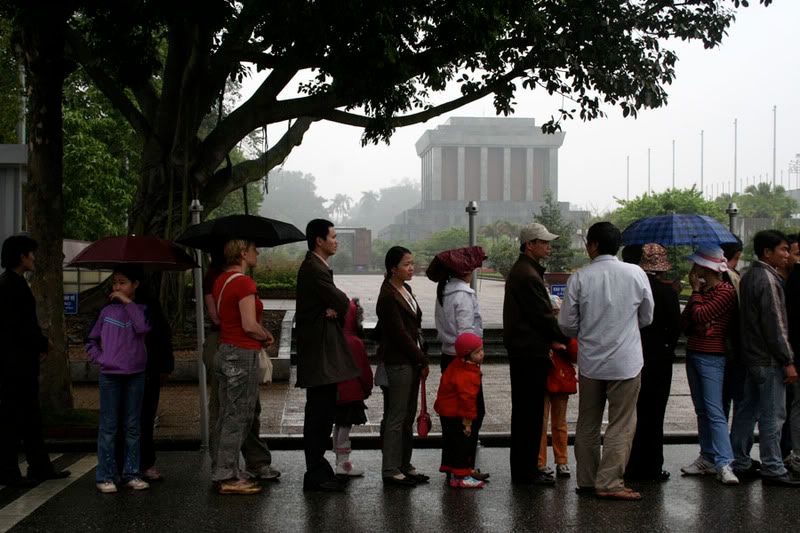 Upon returning to Hanoi, Bordeaux and I began visiting the best of the city's major sites. After a day among museums and Buddhist temples, we decided to follow the crowds and visit Ho Chi Minh's Mausoleum. Leaving behind tree-lined avenues of stately yellow villas, we reached the manicured lawns of the mausoleum complex. The sight of his monumentalist tomb rising above a snaking line of tourists struck me as bizarre, yet somehow I couldn't help but feel a twinge of recognition.
Upon returning to Hanoi, Bordeaux and I began visiting the best of the city's major sites. After a day among museums and Buddhist temples, we decided to follow the crowds and visit Ho Chi Minh's Mausoleum. Leaving behind tree-lined avenues of stately yellow villas, we reached the manicured lawns of the mausoleum complex. The sight of his monumentalist tomb rising above a snaking line of tourists struck me as bizarre, yet somehow I couldn't help but feel a twinge of recognition.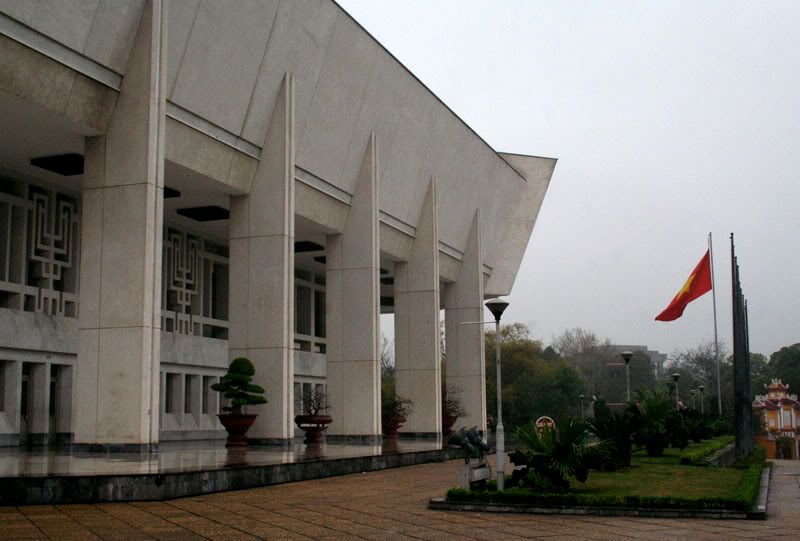 We endured the drizzle at the end of the line, standing quite some distance from Ho Chi Minh's Mausoleum, but eventually my interest waned and I gave up on the prospect of seeing Uncle Ho lying in state. Instead, Bordeaux and I visited the much less crowded Ho Chi Minh museum. Though the museum's building, which reflects the monumental Soviet influence of Ho's tomb, seems rather brutal, its concrete forms are actually meant to evoke the image of the lotus. This creative use of architecture is only a glimpse of the displays housed inside.
We endured the drizzle at the end of the line, standing quite some distance from Ho Chi Minh's Mausoleum, but eventually my interest waned and I gave up on the prospect of seeing Uncle Ho lying in state. Instead, Bordeaux and I visited the much less crowded Ho Chi Minh museum. Though the museum's building, which reflects the monumental Soviet influence of Ho's tomb, seems rather brutal, its concrete forms are actually meant to evoke the image of the lotus. This creative use of architecture is only a glimpse of the displays housed inside.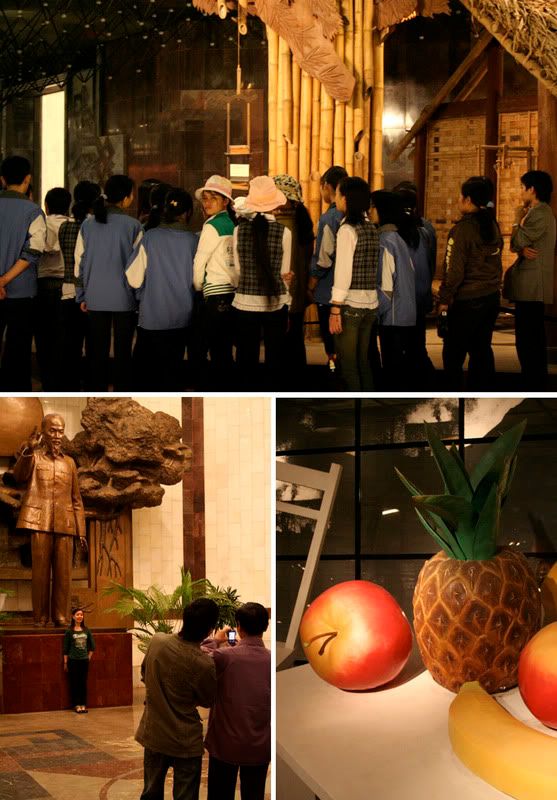 Inside, after paying homage to a bronzed likeness of the man himself, visitors are lead around a complex gallery that's meant to show the world and environment in which Ho Chi Minh lived. But more than a series of didactic displays, the Ho Chi Minh museum is a surprisingly complex work of installation art. Ho's child hood home, a simple bamboo thatch hut, floats on a lotus, showing how he managed to rise above the squalor of his surroundings. A display on colonial Vietnam shows recreations of homes belonging to the Colonial upper and lower classes; the rooms are divided by polished weapons and sharpened bamboo poles, a sign of the discord and unease that class divide created. An exhibit on the early 20th century takes visitors through a maze of mirrors, demonstrating the social and industrial upheaval taking place in the world. Giant fruit on a collapsing table illustrate the future promise of Vietnam's youth... ok, well that one I didn't get. While I can't say if Ho Chi Minh's Mausoleum is worth a visit, I can certainly recommend Ho Chi Minh's museum to anyone interested in Communist propaganda, the history of Vietnam, or installation art.
Inside, after paying homage to a bronzed likeness of the man himself, visitors are lead around a complex gallery that's meant to show the world and environment in which Ho Chi Minh lived. But more than a series of didactic displays, the Ho Chi Minh museum is a surprisingly complex work of installation art. Ho's child hood home, a simple bamboo thatch hut, floats on a lotus, showing how he managed to rise above the squalor of his surroundings. A display on colonial Vietnam shows recreations of homes belonging to the Colonial upper and lower classes; the rooms are divided by polished weapons and sharpened bamboo poles, a sign of the discord and unease that class divide created. An exhibit on the early 20th century takes visitors through a maze of mirrors, demonstrating the social and industrial upheaval taking place in the world. Giant fruit on a collapsing table illustrate the future promise of Vietnam's youth... ok, well that one I didn't get. While I can't say if Ho Chi Minh's Mausoleum is worth a visit, I can certainly recommend Ho Chi Minh's museum to anyone interested in Communist propaganda, the history of Vietnam, or installation art.After leaving the museum via a shop selling Ho Chi Minh collector's plates, I again felt a surge of familiarity. The endless queues, the piped music and loud-speaker announcements, the stands of tacky souvenirs, the polished fountains and trimmed landscaping... it all seemed so strangely familiar. Suddenly, it hit me- I was back in Disneyland, circa 1989. Ho Chi Minh land. Everything about the gleaming white buildings and the stark grounds reminded me of Tomorrowland. Disney's Tomorrowland was such a retro vision of a future, that by my time it was less a vision of optimism than a graying relic of a future that never came to be. And a monument to Ho Chi Minh's idea of a great communist Vietnam isn't that different, really.

Themes:
Hanoi,
museums,
Southeast Asia,
Viet Nam
Friday, March 14, 2008
Binh my pate + trung.
 Is it ridiculous to write about the same street-treat twice on one trip? Not when it’s a dish as delicious as binh my pate. After a morning of Hanoi culture at the Temple of Literature and the Fine Arts Museum, Bordeaux and I began to feel hungry for lunch. Walking down a wide avenue lined with painter’s shops, we finally spotted what we were looking for: a glass case filled with a pyramid of golden baguettes.
Is it ridiculous to write about the same street-treat twice on one trip? Not when it’s a dish as delicious as binh my pate. After a morning of Hanoi culture at the Temple of Literature and the Fine Arts Museum, Bordeaux and I began to feel hungry for lunch. Walking down a wide avenue lined with painter’s shops, we finally spotted what we were looking for: a glass case filled with a pyramid of golden baguettes.As we approached the counter, we were greeted cheerfully by the sandwich lady, a slightly odd woman in silk pajamas. She pointed to the different ingredients in her case. We wanted baguettes? Yet. Pate? Yes. Cilantro, chili, and cucumber? Yes, yes, yes. Egg? Bordeaux and I looked at each other. Egg? No, no egg.
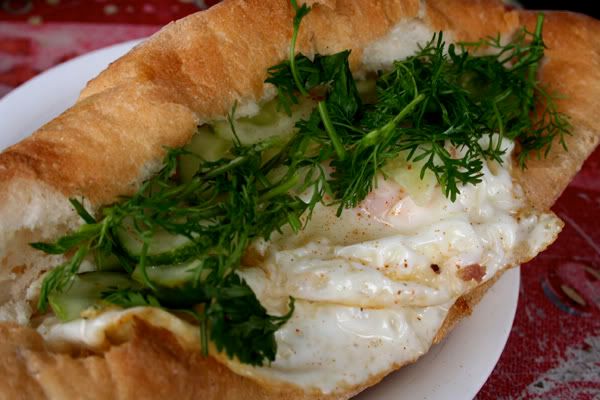 She didn’t understand us. She gave us everything. She set the baguettes out on plastic plates, and quickly fried up the egg along with little blocks of fatty pate. She came and dropped a baguette in front of each of us, returning first with the soft over-easy egg and the sizzling pate, and then with a plate of sliced cucumbers. We decided to try it. We sliced the crusty bread, spread the pate, and slipped in the fried eggs. She came back with a big handful cilantro, which she sprinkled over our sandwiches like confetti. We garnished them, spiced them. The end result was amazing. They were warm, crunchy, greasy, salty, spicy, fresh, and crisp- the perfect combination of flavors in a deceptively simple sandwich. We were lucky that she didn’t understand out order.
She didn’t understand us. She gave us everything. She set the baguettes out on plastic plates, and quickly fried up the egg along with little blocks of fatty pate. She came and dropped a baguette in front of each of us, returning first with the soft over-easy egg and the sizzling pate, and then with a plate of sliced cucumbers. We decided to try it. We sliced the crusty bread, spread the pate, and slipped in the fried eggs. She came back with a big handful cilantro, which she sprinkled over our sandwiches like confetti. We garnished them, spiced them. The end result was amazing. They were warm, crunchy, greasy, salty, spicy, fresh, and crisp- the perfect combination of flavors in a deceptively simple sandwich. We were lucky that she didn’t understand out order.
Themes:
food,
Hanoi,
Southeast Asia,
street-food,
Viet Nam,
Vietnamese Food and Coffee
Thursday, March 13, 2008
On Holiday in Cat Ba Town.
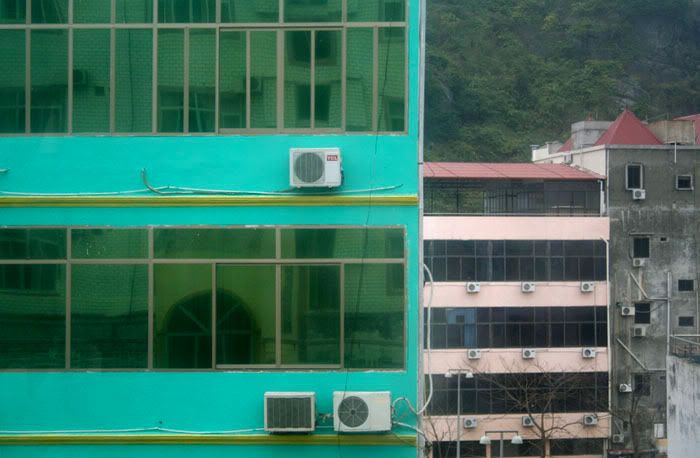 Unfortunately, winter is not as kind to Catba Island as it is to Halong Bay. Where the latter is graced with a mist that creates mystery and allure, the former simply gathers damp.
Unfortunately, winter is not as kind to Catba Island as it is to Halong Bay. Where the latter is graced with a mist that creates mystery and allure, the former simply gathers damp.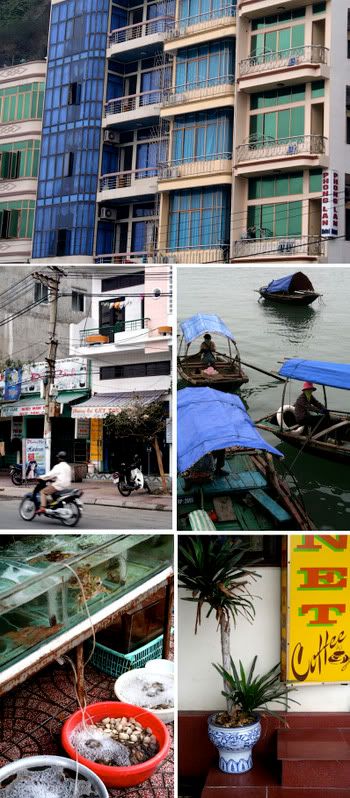 Cat Ba is undoubtedly meant to be a holiday town- hotels are stacked up against the jungle-clad hills, and the oceanfront promenade is decorated in fairy-light sculptures and grandiose fountains. Yet what becomes of it when no one is on holiday? On an off season visit, with no throngs of beach goers and sun chasers, the town simply looks comical- hotel names like Holiday View and Cat Ba Princess become a little ironic in the mildewed haze of March. Yet, strangely, there was something appealing about the lack of appeal, a certain style to its lack of style. And despite the town's downtrodden mood, we had a great time walking the abandoned streets, among lonely pearl stands and quiet seafood joints.
Cat Ba is undoubtedly meant to be a holiday town- hotels are stacked up against the jungle-clad hills, and the oceanfront promenade is decorated in fairy-light sculptures and grandiose fountains. Yet what becomes of it when no one is on holiday? On an off season visit, with no throngs of beach goers and sun chasers, the town simply looks comical- hotel names like Holiday View and Cat Ba Princess become a little ironic in the mildewed haze of March. Yet, strangely, there was something appealing about the lack of appeal, a certain style to its lack of style. And despite the town's downtrodden mood, we had a great time walking the abandoned streets, among lonely pearl stands and quiet seafood joints.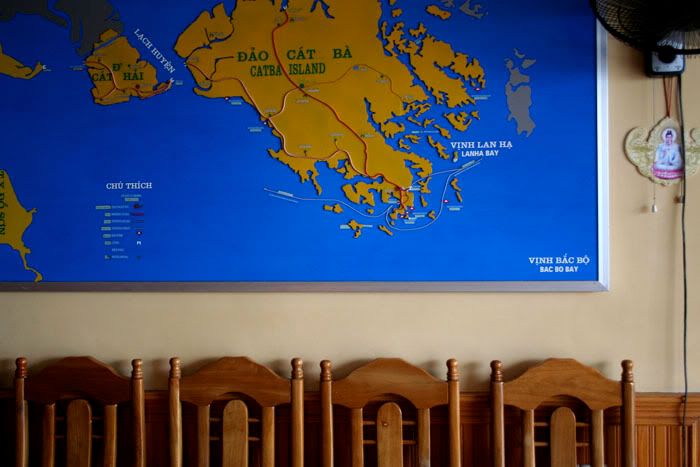
Wednesday, March 12, 2008
Halong Winter.
 The trip out of Hanoi was so spectacular as to seem cliche. Between towns of gaudy neoclassical tube-houses, we passed scenes of rural Vietnamese life so postcard-perfect they seemed as if they had been staged. Black and white ducks crowded in a bamboo cage, teetering off the edge of a motorcycle; women in conical hats working in flooded plains that glowed with electric-green rice buds; water-buffalo lazing in the shade, their fur caked with mud. But as attractive as these scenes were, they couldn't rival our destination: Halong Bay.
The trip out of Hanoi was so spectacular as to seem cliche. Between towns of gaudy neoclassical tube-houses, we passed scenes of rural Vietnamese life so postcard-perfect they seemed as if they had been staged. Black and white ducks crowded in a bamboo cage, teetering off the edge of a motorcycle; women in conical hats working in flooded plains that glowed with electric-green rice buds; water-buffalo lazing in the shade, their fur caked with mud. But as attractive as these scenes were, they couldn't rival our destination: Halong Bay. The guidebooks told us that March was the worst time to visit, but we discovered that Halong Bay in winter is chilly, foggy, and perfectly atmospheric. In the morning, veils of mist hung off the jagged-edges of karsts. In the afternoon, the sun drew the mist away, revealing bamboo groves clinging over shrines carved into the rock-face. As we kayaked among dragon-tooth peaks and squat wooden junks, we spied giant jellyfish floating in the teal waters below us, their pale pink tendrils trailing behind them.
The guidebooks told us that March was the worst time to visit, but we discovered that Halong Bay in winter is chilly, foggy, and perfectly atmospheric. In the morning, veils of mist hung off the jagged-edges of karsts. In the afternoon, the sun drew the mist away, revealing bamboo groves clinging over shrines carved into the rock-face. As we kayaked among dragon-tooth peaks and squat wooden junks, we spied giant jellyfish floating in the teal waters below us, their pale pink tendrils trailing behind them.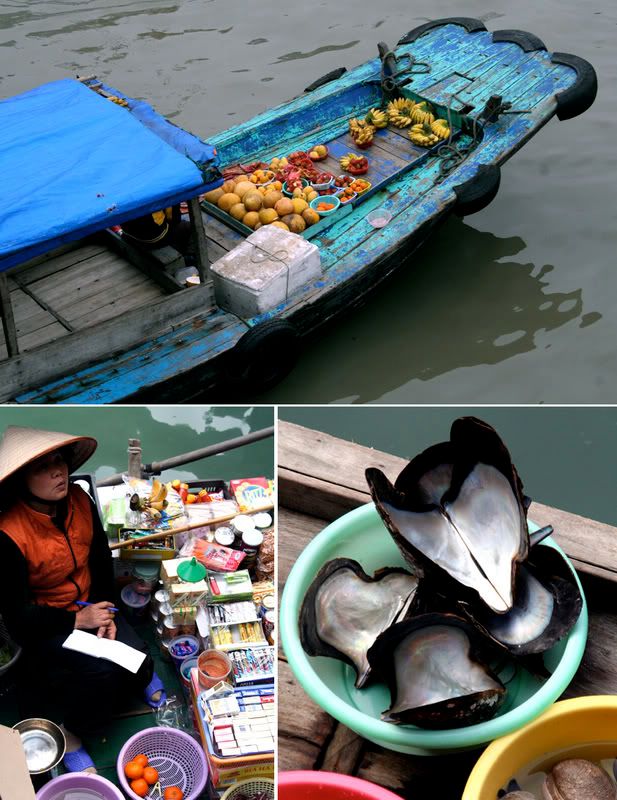 Where tourists and visitors gathered, so too did floating market sampans. From boats of wooden and woven bamboo, women offered oranges, Ritz crackers, and boxes of cigarettes. Some had large plastic tubs; they offered crabs, cuttlefish, and fist-sized clams, their mother of pearl interiors gleaming.
Where tourists and visitors gathered, so too did floating market sampans. From boats of wooden and woven bamboo, women offered oranges, Ritz crackers, and boxes of cigarettes. Some had large plastic tubs; they offered crabs, cuttlefish, and fist-sized clams, their mother of pearl interiors gleaming.
Tuesday, March 11, 2008
Cold weather flavors.
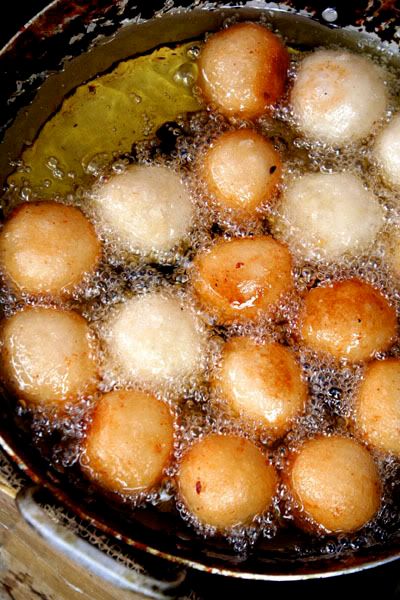 Our train pulled into Lao Cai in the late mornings of night, before the sun rose above the mountains. With luggage on our backs and a biting cold mist hanging around our shoulders, we climbed across platforms and stepped over train tracks, ignoring the inviting calls of touts. A minibus took us on the next leg of our journey. As we curved along mountain passes, we watched the morning light settle among quiet towns and groves of dark bamboo. We arrived at our destination under heavy cloak of fog. As they climbed out of the minivan, the other passengers bundled up against the bracing weather, but I breathed the sharp air in.
Our train pulled into Lao Cai in the late mornings of night, before the sun rose above the mountains. With luggage on our backs and a biting cold mist hanging around our shoulders, we climbed across platforms and stepped over train tracks, ignoring the inviting calls of touts. A minibus took us on the next leg of our journey. As we curved along mountain passes, we watched the morning light settle among quiet towns and groves of dark bamboo. We arrived at our destination under heavy cloak of fog. As they climbed out of the minivan, the other passengers bundled up against the bracing weather, but I breathed the sharp air in.Most people visit Sapa for the hill tribe trekking; Bordeaux and I visited visited for the cold.
Living in steamy tropical Bangkok, few things seems as exotic as cold weather. So when we laid out our plans for visiting Northern Vietnam, we made sure to include this tiny hill station near the border of China. While I had known that the weather would be drastically different, I hadn't realized how profoundly that difference would resonate in the food.
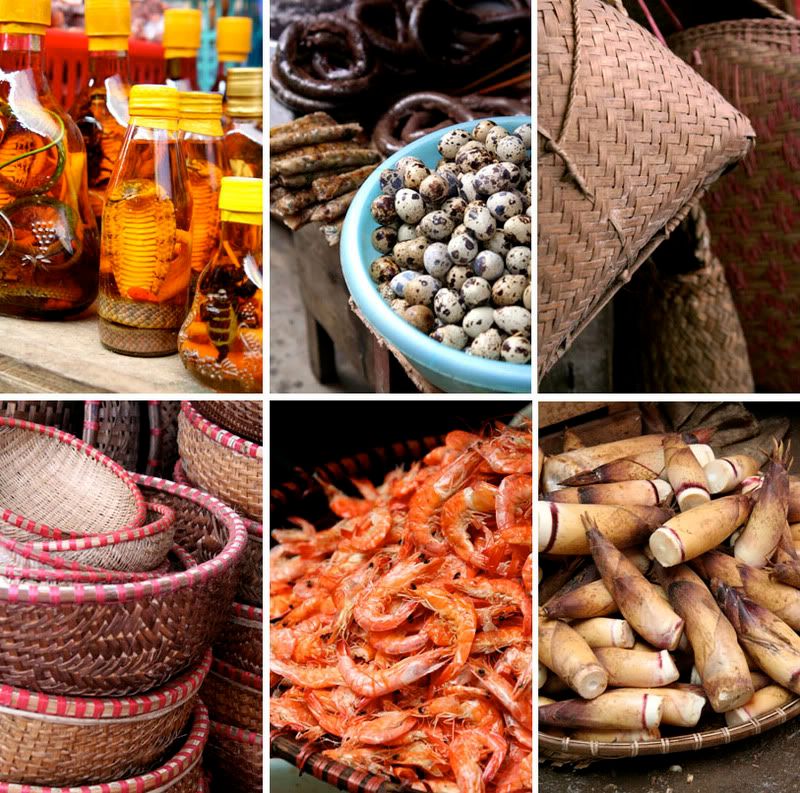 Likely the most interesting sight in town is the busy market, which serves people from all over the region. All around the market, vendors sold different snacks. There were piles of vegetables, stacks of bamboo baskets, and bowls of delicately painted quail eggs. As we explored, Bordeaux and I were pursued by Hmong women, who sold beautiful patterned blankets in deep blues and electric greens. We were also called out to by seated vendors, who sold strange snacks from cover of umbrella.
Likely the most interesting sight in town is the busy market, which serves people from all over the region. All around the market, vendors sold different snacks. There were piles of vegetables, stacks of bamboo baskets, and bowls of delicately painted quail eggs. As we explored, Bordeaux and I were pursued by Hmong women, who sold beautiful patterned blankets in deep blues and electric greens. We were also called out to by seated vendors, who sold strange snacks from cover of umbrella.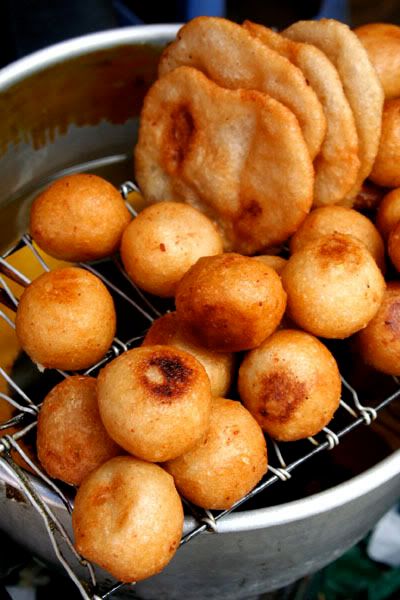 These first treat I tried was the above, which tempted me with its singed golden skin. Though they looked like round doughnuts, these were actually deep fried balls of sticky rice. The coating was tasty and crisp, with a soft rice interior that concealed a filling of pounded yellow mung beans.
These first treat I tried was the above, which tempted me with its singed golden skin. Though they looked like round doughnuts, these were actually deep fried balls of sticky rice. The coating was tasty and crisp, with a soft rice interior that concealed a filling of pounded yellow mung beans.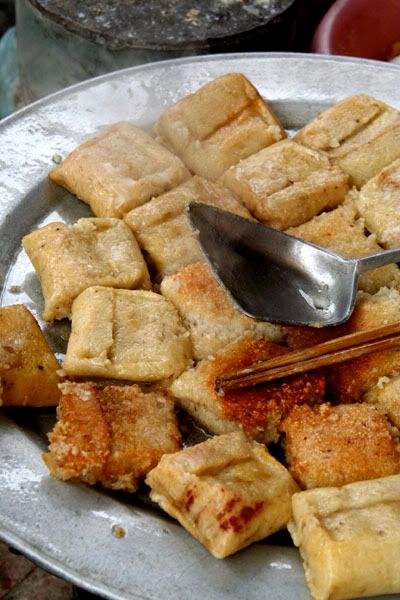 Rather similar was this sticky rice treat. Rice was steamed into blocks in banana leaves, then grilled lightly in a large pan. The rice was soft, with a subtle flavor from the leaf.
Rather similar was this sticky rice treat. Rice was steamed into blocks in banana leaves, then grilled lightly in a large pan. The rice was soft, with a subtle flavor from the leaf.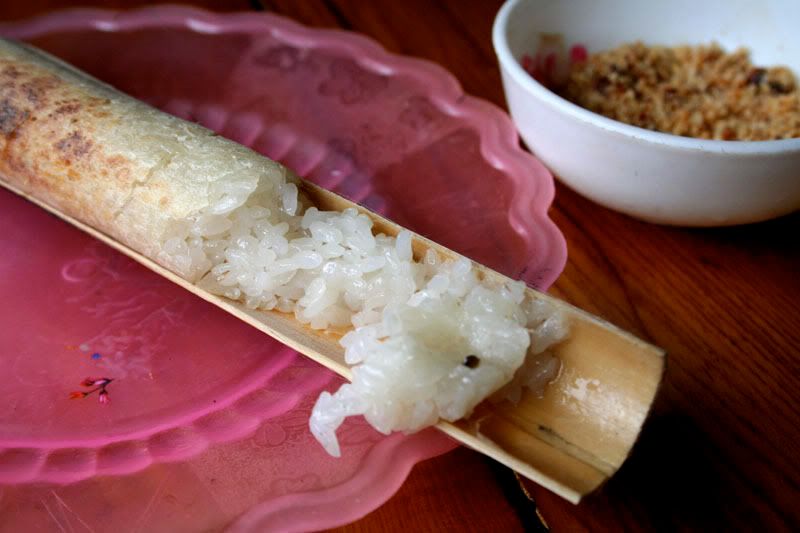 At a market restaurant, we ate a simple lunch of hot soup. Far more interesting than our meal, however, was the accompaniment: sticky rice grilled in a bamboo shell. It was served with a dish of crushed, salted peanuts. Dipped into the salty coating, it was like a Sapa candy bar.
At a market restaurant, we ate a simple lunch of hot soup. Far more interesting than our meal, however, was the accompaniment: sticky rice grilled in a bamboo shell. It was served with a dish of crushed, salted peanuts. Dipped into the salty coating, it was like a Sapa candy bar.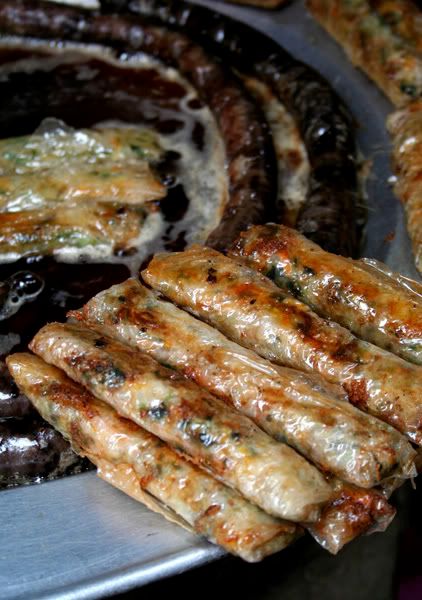 Not all of the dishes looked equally tempting. At first, I mistook this snack as a greasy sausage. It was actually an interesting take on a spring roll: a crunchy filling wrapped in silk-thin rice paper, and fried among a coiled sausage for added flavoring. It was hot and crispy, with a tasty filling of fresh vegetables. It was the most flavorful snack we ate- which really isn't saying much. The food in Sapa was tasty, but it was profoundly simple, and mostly very subtly flavored. It's a cuisine that makes sense, given the climate. Here in these cold mountains, among the starchy mild flavors of a long winter, we felt continents away from our spicy tropical home. Which, I suppose, was the point of the journey.
Not all of the dishes looked equally tempting. At first, I mistook this snack as a greasy sausage. It was actually an interesting take on a spring roll: a crunchy filling wrapped in silk-thin rice paper, and fried among a coiled sausage for added flavoring. It was hot and crispy, with a tasty filling of fresh vegetables. It was the most flavorful snack we ate- which really isn't saying much. The food in Sapa was tasty, but it was profoundly simple, and mostly very subtly flavored. It's a cuisine that makes sense, given the climate. Here in these cold mountains, among the starchy mild flavors of a long winter, we felt continents away from our spicy tropical home. Which, I suppose, was the point of the journey.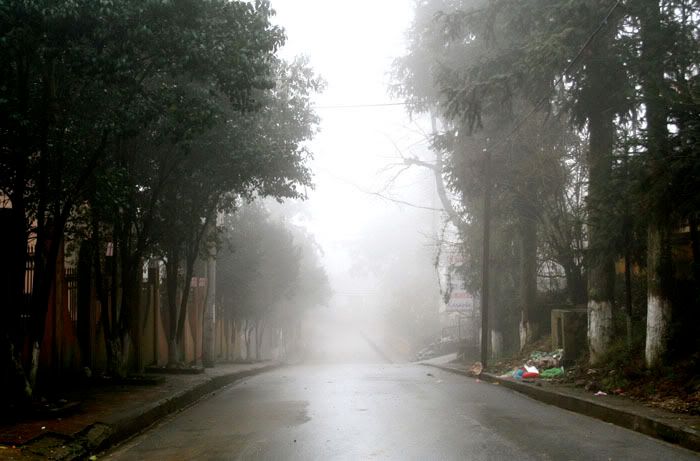 For a different account of our activities, be sure to check out Bordeaux's entry on Sapa at his blog, Maritasays.
For a different account of our activities, be sure to check out Bordeaux's entry on Sapa at his blog, Maritasays.
Themes:
Adventure,
food,
Southeast Asia,
street-food,
Viet Nam,
Vietnamese Food and Coffee
Monday, March 10, 2008
The dapper old gents of Hanoi.
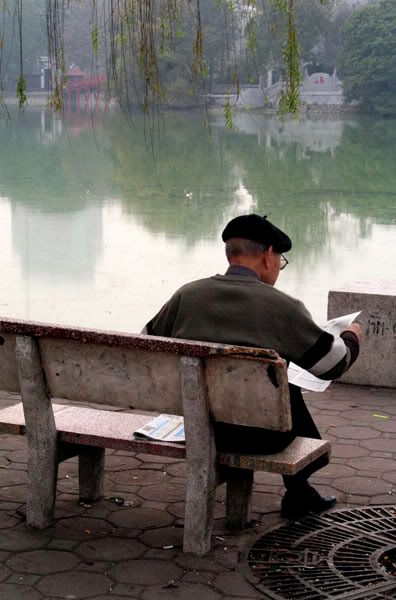 With its tree-lined avenues and elegant architecture, Hanoi undoubtedly has a certain sophistication. That charm is defined by the nattily dressed older gentlemen that stroll Hanoi's lakes, and sip coffee in its sidewalk cafes. Even as they advance in years, the remain undeniably sharp in gray fedoras, black berets, and tweed coats.
With its tree-lined avenues and elegant architecture, Hanoi undoubtedly has a certain sophistication. That charm is defined by the nattily dressed older gentlemen that stroll Hanoi's lakes, and sip coffee in its sidewalk cafes. Even as they advance in years, the remain undeniably sharp in gray fedoras, black berets, and tweed coats.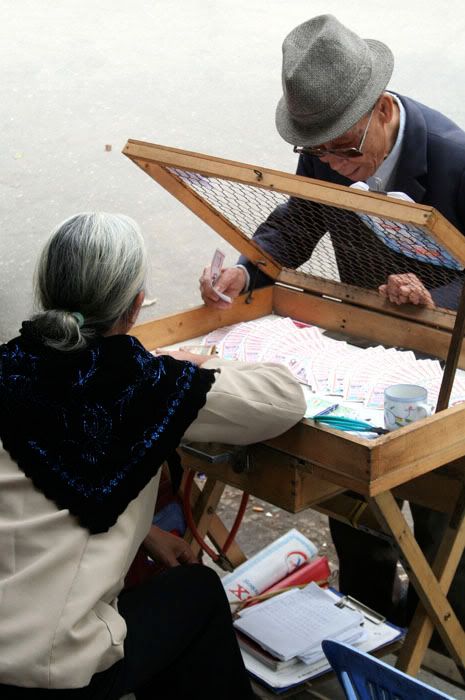
Themes:
Hanoi,
Southeast Asia,
Style and Design,
Viet Nam
Sunday, March 09, 2008
Pho.
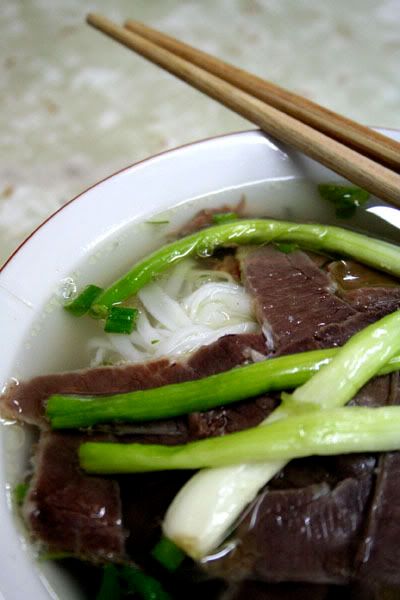 On our second morning in Hanoi, Bordeaux and I went in search of breakfast among the twisting alleys of the old quarter. Down a lane crowded with low market tables, we spotted a busy shop house kitchen. At the entrance, one woman scooped handfuls of white noodles into a metal pot, while another deftly sliced at various cuts of beef. Inside, patrons were crowded at plastic tables. The cold morning air was parted by drapes of white steam, in which we caught the alluring scent of star anise and cinnamon. We ordered at the counter, and waited for our breakfast.
On our second morning in Hanoi, Bordeaux and I went in search of breakfast among the twisting alleys of the old quarter. Down a lane crowded with low market tables, we spotted a busy shop house kitchen. At the entrance, one woman scooped handfuls of white noodles into a metal pot, while another deftly sliced at various cuts of beef. Inside, patrons were crowded at plastic tables. The cold morning air was parted by drapes of white steam, in which we caught the alluring scent of star anise and cinnamon. We ordered at the counter, and waited for our breakfast.Of all the dishes available at sidewalk kitchens around Hanoi, pho is perhaps the one most worth trying. Not because it is the most delicious- certainly there are far tastier dishes- and not because it is the dish most reflective of Vietnamese cuisine. Rather, it is because while other dishes can be made well at home or in restaurants, pho is best when made in street kitchens. This is because the perfect broth must be made over a long time, the beef bones having simmered for more than 24 hours. Furthemore, at pho stands the chef makes only one thing, so she must make it well.
Our bowls were sloshed onto the table in front of us. Thin slices of beef and whole spring onions rested on a cushion of white noodles. With one hand tilting a metal spoon and the other weaving chopsticks, we set to work. The golden broth was rich and delicately spiced, but it was only a canvas onto which to create. Bordeaux scooped a ladleful of chili paste into his bowl, swirling in the spicy red tint. I squeezed in a lime half, giving my dish a fresh tart citrus edge. The warm broth heated our half-asleep bodies, while the wisps of white steam curled around us, trapping us with its exotic spices and flavors.
Themes:
breakfast,
food,
Hanoi,
Southeast Asia,
Viet Nam,
Vietnamese Food and Coffee
Saturday, March 08, 2008
Indochine treat.
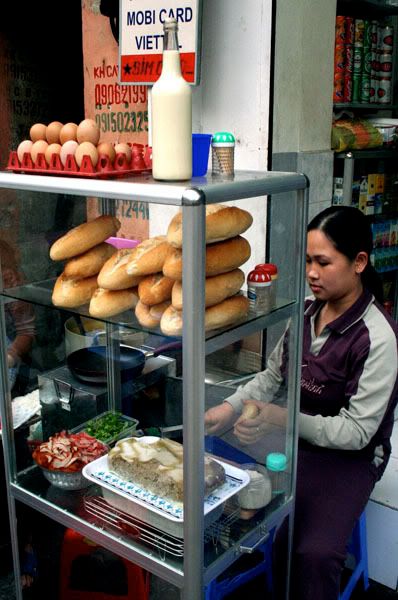 Coming back to Vietnam, there was one food that Bordeaux and I were anticipating beyond all others. Sure, we were looking forward to pho, and were eager to have shrimp on sugarcane again, but one treat was truly tempting us. Thankfully, we didn’t have to walk too far in Hanoi on our first morning before we found a young girl selling it. We recognized her by the stack of golden baguettes in her class case; we confirmed what she was selling with the sight of a long block of fatty meat on a shelf below. We ordered two, and she quickly set to work. After a minute, she handed us two filled baguettes, two binh my pate, wrapped in old newspaper.
Coming back to Vietnam, there was one food that Bordeaux and I were anticipating beyond all others. Sure, we were looking forward to pho, and were eager to have shrimp on sugarcane again, but one treat was truly tempting us. Thankfully, we didn’t have to walk too far in Hanoi on our first morning before we found a young girl selling it. We recognized her by the stack of golden baguettes in her class case; we confirmed what she was selling with the sight of a long block of fatty meat on a shelf below. We ordered two, and she quickly set to work. After a minute, she handed us two filled baguettes, two binh my pate, wrapped in old newspaper. We had become rather addicted to these distinctive Indonchine sandwiches while traveling through Laos, Cambodia, and Vietnam, and so it was with some restraint that we waited until we got to a bench on the Hoan Kiem lake before we unwrapped them. They were perfect, just as good as we had remembered. Crusty, fresh baguettes, overfilled with cilantro, cold meats, and a salty spread of pate. This one was also enhanced with the addition of charred garlic, adding a flavor that was perfect for the chilly Hanoi morning. It was a great way to be welcomed back to Vietnam.
We had become rather addicted to these distinctive Indonchine sandwiches while traveling through Laos, Cambodia, and Vietnam, and so it was with some restraint that we waited until we got to a bench on the Hoan Kiem lake before we unwrapped them. They were perfect, just as good as we had remembered. Crusty, fresh baguettes, overfilled with cilantro, cold meats, and a salty spread of pate. This one was also enhanced with the addition of charred garlic, adding a flavor that was perfect for the chilly Hanoi morning. It was a great way to be welcomed back to Vietnam.
Themes:
breakfast,
food,
Hanoi,
Southeast Asia,
street-food,
Viet Nam,
Vietnamese Food and Coffee
Through the city-gate.
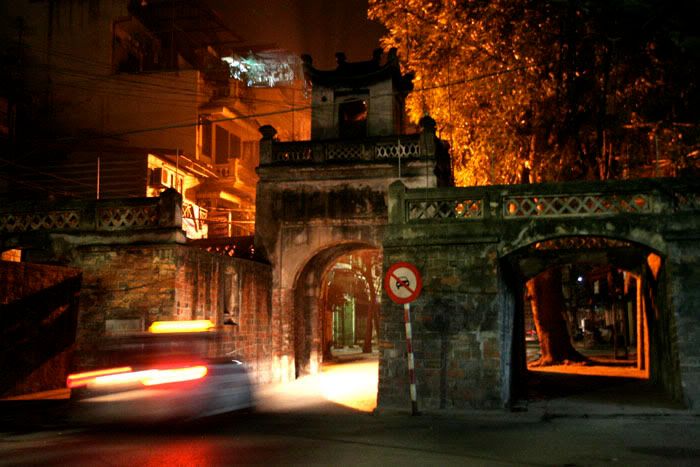 Turning off the highway, our taxi scratchs on rough pavement as it crawls through a crack into the old city. It curves through an alley, the headlights suddenly lighting up the imperial City-Gate before disappearing through it. We've arrived in the Old Quarter of Hanoi.
Turning off the highway, our taxi scratchs on rough pavement as it crawls through a crack into the old city. It curves through an alley, the headlights suddenly lighting up the imperial City-Gate before disappearing through it. We've arrived in the Old Quarter of Hanoi.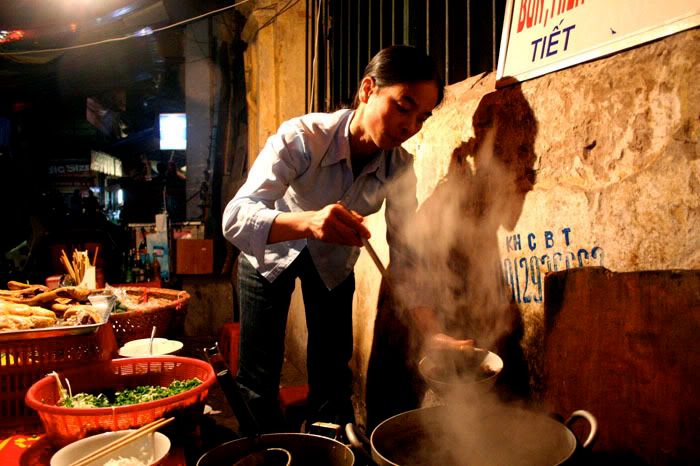 Bordeaux and I head out into the city, in search of dinner. Seen for the first time at night, Hanoi keeps itself hidden. It feels European; like the crowded labyrinths of Barcelona, or the cold crowded sidewalks of night in Istanbul. Families sit having a late dinner on sidewalk tables; children disappear down telescoping alleyways. We find an intersection busy with foodstands. The air is bitingly cold, so we choose the woman whose soup pots are giving off the biggest clouds of steam. We order two bowls of whatever she is serving, and she nods in understanding. She grabs a handful of viscous white noodles, and drops it into a basket in one of the steaming pots. She chops poultry meat, dishes out the yellow broth and warmed noodles, garnishes the dish with fresh cilantro, and serves it to us. The dish is delicious. Fat slivers of duck pile over slightly sour pickled bamboo in a rich, garlicy broth. It warms us up perfectly.
Bordeaux and I head out into the city, in search of dinner. Seen for the first time at night, Hanoi keeps itself hidden. It feels European; like the crowded labyrinths of Barcelona, or the cold crowded sidewalks of night in Istanbul. Families sit having a late dinner on sidewalk tables; children disappear down telescoping alleyways. We find an intersection busy with foodstands. The air is bitingly cold, so we choose the woman whose soup pots are giving off the biggest clouds of steam. We order two bowls of whatever she is serving, and she nods in understanding. She grabs a handful of viscous white noodles, and drops it into a basket in one of the steaming pots. She chops poultry meat, dishes out the yellow broth and warmed noodles, garnishes the dish with fresh cilantro, and serves it to us. The dish is delicious. Fat slivers of duck pile over slightly sour pickled bamboo in a rich, garlicy broth. It warms us up perfectly. Not yet feeling tired, we decide to stop for a beer. We take low seats at a busy corner restaurant. The floor below the plastic tables is filthy; dirtier even than the street or sidewalk. It’s a battlefield of pigeon bones, rust-brown gristle, and emptied shells of lime. Ironically, the discarded lime gives the street corner a clean, citrus aroma. The waitstaff hurry around among the crowded plastic tables, dropping off cans of Hanoi Beer and cold mugs in front of us. Well dressed men and sharply styled women arrive in groups, eat quickly, and jet off again. One of the waiters stops for a smoke on the parked bikes. I lift my camera, and he strikes a pose for me.
Not yet feeling tired, we decide to stop for a beer. We take low seats at a busy corner restaurant. The floor below the plastic tables is filthy; dirtier even than the street or sidewalk. It’s a battlefield of pigeon bones, rust-brown gristle, and emptied shells of lime. Ironically, the discarded lime gives the street corner a clean, citrus aroma. The waitstaff hurry around among the crowded plastic tables, dropping off cans of Hanoi Beer and cold mugs in front of us. Well dressed men and sharply styled women arrive in groups, eat quickly, and jet off again. One of the waiters stops for a smoke on the parked bikes. I lift my camera, and he strikes a pose for me.
Themes:
food,
Hanoi,
nocturne,
Southeast Asia,
street-food,
Viet Nam,
Vietnamese Food and Coffee
Subscribe to:
Posts (Atom)

